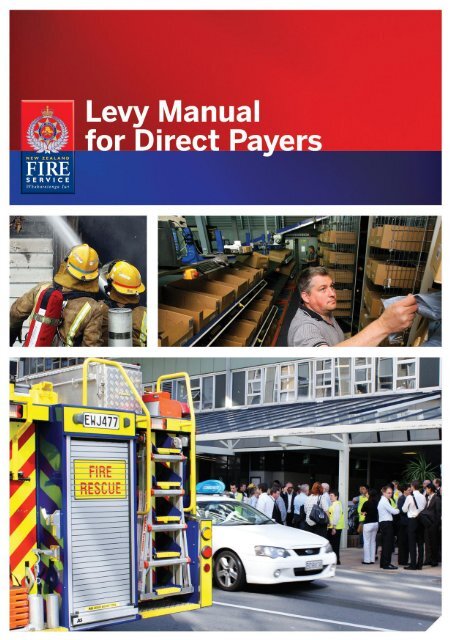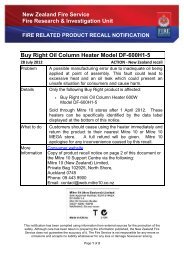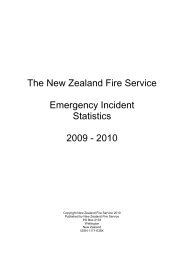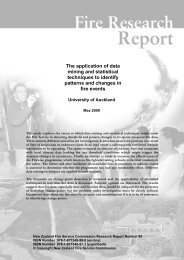A guide to the New Zealand Fire Service Levy
A guide to the New Zealand Fire Service Levy
A guide to the New Zealand Fire Service Levy
Create successful ePaper yourself
Turn your PDF publications into a flip-book with our unique Google optimized e-Paper software.
<strong>Levy</strong> Manual for Direct Payers 1
<strong>Levy</strong> Manual for Direct Payers<br />
<strong>Fire</strong> <strong>Service</strong> <strong>Levy</strong> provides around 95% of <strong>the</strong> funding for <strong>the</strong> operations of <strong>the</strong> <strong>New</strong><br />
<strong>Zealand</strong> <strong>Fire</strong> <strong>Service</strong> as set out in <strong>the</strong> <strong>Fire</strong> <strong>Service</strong> Act (1975). <strong>Levy</strong> is payable on all<br />
contracts of fire insurance for all assets insured in <strong>New</strong> <strong>Zealand</strong>.<br />
<strong>Levy</strong> is currently calculated at 7.6 c per $100 sum insured. This is subject <strong>to</strong> upper limits for a number of<br />
items such as:<br />
residential buildings,<br />
domestic contents and<br />
mo<strong>to</strong>r vehicles not exceeding 3.5 <strong>to</strong>nnes gross laden weight.<br />
Where <strong>the</strong> indemnity value of <strong>the</strong> assets is less than <strong>the</strong> sum insured, levy is payable on <strong>the</strong> indemnity value.<br />
GST is payable in addition <strong>to</strong> any amount of levy. The current rate of GST is 15%.<br />
Manual Contents<br />
Who pays levy and when is it due?<br />
How is levy paid?<br />
<strong>Levy</strong> payable on mo<strong>to</strong>r vehicles<br />
<strong>Levy</strong> payable on residential buildings and personal property<br />
<strong>Levy</strong> payable on contract extensions<br />
<strong>Levy</strong> payable on all o<strong>the</strong>r assets<br />
Calculating levy<br />
Penalties<br />
Assessments and audits<br />
Items exempt under <strong>the</strong> Third Schedule<br />
<strong>Levy</strong> Manual for Direct Payers 2
Who pays levy and when is it due?<br />
All property owners who insure property in <strong>New</strong> <strong>Zealand</strong> against <strong>the</strong> risk of fire pay a levy.<br />
Responsibility for calculating and making payment of <strong>the</strong> <strong>Fire</strong> <strong>Service</strong> levy depends on how <strong>the</strong> insurance<br />
cover is being arranged.<br />
Where <strong>the</strong>re is a <strong>New</strong> <strong>Zealand</strong>-based insurer involved in <strong>the</strong> policy, levy is payable by <strong>the</strong> insurer<br />
(based upon <strong>the</strong> proportion of insurance).<br />
Where <strong>the</strong>re is not a <strong>New</strong> <strong>Zealand</strong>-based insurer, but <strong>the</strong>re is a <strong>New</strong> <strong>Zealand</strong>-based broker, levy is<br />
payable by <strong>the</strong> broker<br />
In all o<strong>the</strong>r circumstances, levy is payable <strong>to</strong> <strong>the</strong> Commission by <strong>the</strong> insured.<br />
The forms that should be sent with, or shortly after <strong>the</strong> payment of levy by <strong>the</strong> insured are:<br />
SITUATION FORMS REQUIRED<br />
Where <strong>the</strong>re is a contract of fire insurance<br />
covering assets<br />
Where <strong>the</strong>re is a provision or reserve set aside <strong>to</strong><br />
cover loss by fire or where <strong>the</strong>re are any o<strong>the</strong>r<br />
arrangements similar <strong>to</strong> a contract of fire<br />
insurance<br />
Form 2, Form 3,<br />
Form 4, Form 5,<br />
<strong>Fire</strong> <strong>Service</strong> <strong>Levy</strong> is due on <strong>the</strong> 15th day of <strong>the</strong> second month following commencement of <strong>the</strong> policy. For<br />
example, if a policy covers <strong>the</strong> insurance period 30 June 2012 <strong>to</strong> 30 June 2013, levy is payable in full on 15<br />
August 2012, regardless of when <strong>the</strong> premium is paid.<br />
The NZFS uses advertising <strong>to</strong> alert <strong>the</strong> public <strong>to</strong> <strong>the</strong>ir obligation <strong>to</strong> pay levy and sends reminder letters <strong>to</strong><br />
people who have previously paid levy. However, <strong>the</strong> calculation and payment of levy ultimately falls on <strong>the</strong><br />
party that is responsible for payment.<br />
<strong>Levy</strong> Manual for Direct Payers 3
How is levy paid?<br />
We prefer payments by direct credit <strong>to</strong> <strong>the</strong> <strong>New</strong> <strong>Zealand</strong> <strong>Fire</strong> <strong>Service</strong> bank account:<br />
<strong>New</strong> <strong>Zealand</strong> <strong>Fire</strong> <strong>Service</strong> Commission<br />
Bank of <strong>New</strong> <strong>Zealand</strong><br />
North End Branch – Welling<strong>to</strong>n<br />
02-0536-0062111-00<br />
SWIFT: BKNZNZ22<br />
Payments can be also be made via cheque <strong>to</strong>:<br />
The Revenue Team<br />
<strong>New</strong> <strong>Zealand</strong> <strong>Fire</strong> <strong>Service</strong><br />
PO Box 2133<br />
Welling<strong>to</strong>n 6140<br />
Please ensure that <strong>the</strong> word ―levy‖ and <strong>the</strong> period that <strong>the</strong> payment relates <strong>to</strong> (i.e. 2010/11) are included in<br />
<strong>the</strong> explanation field.<br />
Common errors when calculating and paying levy include –<br />
Calculating <strong>the</strong> levy due based on <strong>the</strong> premium ra<strong>the</strong>r than <strong>the</strong> Indemnity Value or Sum Insured<br />
Not including GST or not calculating GST correctly<br />
Not calculating levy in $NZD<br />
Paying from offshore and not ensuring bank fees/costs are paid in full by <strong>the</strong> levy payer<br />
All payments of levy that are calculated and paid directly <strong>to</strong> <strong>the</strong> <strong>New</strong> <strong>Zealand</strong> <strong>Fire</strong> <strong>Service</strong> must be<br />
accompanied by <strong>the</strong> appropriate forms as shown in <strong>the</strong> table in <strong>the</strong> previous section.<br />
The Statu<strong>to</strong>ry Declaration must be witnessed by a Justice of <strong>the</strong> Peace, a notary public, a person enrolled as<br />
a barrister and solici<strong>to</strong>r of <strong>the</strong> High Court or any o<strong>the</strong>r person authorised <strong>to</strong> witness a Statu<strong>to</strong>ry Declaration<br />
under <strong>the</strong> Oaths and Declarations Act 1957.<br />
Copies of <strong>the</strong>se forms are downloadable from our website, http://www.fire.org.nz under <strong>the</strong> levy section.<br />
<strong>Levy</strong> payable on mo<strong>to</strong>r vehicles<br />
<strong>Levy</strong> is payable at a flat rate of $6.08 per mo<strong>to</strong>r vehicle not exceeding 3.5 <strong>to</strong>nnes gross laden weight.<br />
Definitions of <strong>the</strong> terms are in <strong>the</strong> Land Transport Act and Road User Charges Act.<br />
<strong>Levy</strong> on all o<strong>the</strong>r ‗vehicles‘ (over 3.5 <strong>to</strong>nnes gross laden weight) is calculated in <strong>the</strong> same manner as 'o<strong>the</strong>r<br />
property'.<br />
<strong>Levy</strong> Manual for Direct Payers 4
<strong>Levy</strong> payable on residential buildings and personal property<br />
<strong>Fire</strong> <strong>Service</strong> <strong>Levy</strong> is payable on all assets insured against <strong>the</strong> risk of fire, but residential buildings and<br />
personal property are subject <strong>to</strong> a limit.<br />
Section 48(6) of <strong>the</strong> <strong>Fire</strong> <strong>Service</strong> Act states that <strong>the</strong> amount for which <strong>the</strong> property is insured for <strong>the</strong> contract<br />
of fire insurance shall be—<br />
(a) In <strong>the</strong> case of residential building as defined in section 2(1) of <strong>the</strong> Earthquake Commission Act<br />
1993, <strong>the</strong> amount for which that building is insured pursuant <strong>to</strong> section 18 of that Act:<br />
(b) In <strong>the</strong> case of personal property as defined in section 2(1) of <strong>the</strong> Earthquake Commission Act<br />
1993, <strong>the</strong> amount for which that property is insured pursuant <strong>to</strong> section 20 of that Act:<br />
Clarification on <strong>the</strong> types of buildings that are subject <strong>to</strong> a limit are in <strong>the</strong> Earthquake Commission <strong>guide</strong> at:<br />
http://www.eqc.govt.nz/sites/public_files/insurers-<strong>guide</strong>-september-2012.pdf<br />
<strong>Levy</strong> payable on contract extentions<br />
<strong>Levy</strong> is payable on policy extensions if <strong>the</strong>y increase <strong>the</strong> sum insured during <strong>the</strong> policy period. The two most<br />
common examples of <strong>the</strong>se types of extensions are contract works and capital additions. All levy payable<br />
should be assessed on <strong>the</strong>se types of insurance and it is payable at <strong>the</strong> inception of <strong>the</strong> policy and for <strong>the</strong><br />
period of <strong>the</strong> insurance.<br />
Where <strong>the</strong> extensions are not fully utilised during <strong>the</strong> period of insurance, <strong>the</strong> unused portion of levy may be<br />
offset against <strong>the</strong> levy payable for <strong>the</strong> current period. Given this may be subject <strong>to</strong> an audit, appropriate<br />
records must be kept.<br />
Where <strong>the</strong> amount of <strong>the</strong> sum insured under <strong>the</strong> contract extension represents <strong>the</strong> estimated completed<br />
value of all of <strong>the</strong> property, that amount shall be used as <strong>the</strong> indemnity value of that property. For any global<br />
policies, <strong>the</strong> amount shown in <strong>the</strong> policy shall be used, unless a local (NZ) limit is specified.<br />
Contract works policies<br />
No variation or discount of levy is allowed for existing completed property that is also insured within a<br />
contract works insurance policy, as levy is payable on all contracts of fire insurance.<br />
Where work is being undertaken on properties that are subject <strong>to</strong> limits or exempted, <strong>the</strong>n <strong>the</strong> amount of levy<br />
may be reduced (see calculations below). Where work is being done on exempted assets, it does not<br />
au<strong>to</strong>matically make <strong>the</strong> contract works policy exempt from levy, as <strong>the</strong> policy would provide fire cover for<br />
assets o<strong>the</strong>r than what is being built.<br />
If <strong>the</strong> construction insurance continues <strong>to</strong> apply after <strong>the</strong> end of <strong>the</strong> period of construction and/or during any<br />
period of maintenance, levy will be calculated on that value without discount for <strong>the</strong> period of that insurance.<br />
<strong>Levy</strong> Manual for Direct Payers 5
There are two methods for calculating contract works levy. These are:<br />
Option A<br />
The sum insured shall be deemed <strong>to</strong> represent <strong>the</strong> indemnity value of <strong>the</strong> property<br />
and levy shall be calculated on that value. A discount fac<strong>to</strong>r of 50% is applied <strong>to</strong> reflect <strong>the</strong> fact that <strong>the</strong> value<br />
of <strong>the</strong> works undertaken increases progressively over <strong>the</strong> period. This value is <strong>the</strong>n pro-rated for <strong>the</strong> period<br />
of <strong>the</strong> insurance contract.<br />
Assuming a sum insured of $2 million for a period of insurance of 6 months, levy payable under this option<br />
would be $380, calculated as follows:<br />
Sum Insured (multiplied by) $2,000,000<br />
<strong>Levy</strong> Rate (multiplied by) 7.6 cents per $100 insured<br />
Pro rata period (multiplied by) 50%<br />
Period of cover 6/12 months<br />
Option B<br />
Option B allows for levy <strong>to</strong> be calculated based upon an estimated value of property at <strong>the</strong> end of each<br />
applicable period. Given <strong>the</strong>se are estimates of <strong>the</strong> work that should be completed; <strong>the</strong> levy rate applies <strong>to</strong><br />
<strong>the</strong> estimated values without <strong>the</strong> benefit of <strong>the</strong> 50% discount.<br />
Assuming <strong>the</strong> same circumstances as above, but that <strong>the</strong> value of work completed in each of <strong>the</strong> first two<br />
months would be $500,000, and <strong>the</strong>reafter at $250,000 per month, levy under this option would be $506.67,<br />
calculated as follows:<br />
Estimated month end value (multiplied by) $500,000 - $2,000,000<br />
<strong>Levy</strong> rate (multiplied by) 7.6 cents per $100 insured<br />
Period of cover 1/12 months<br />
Month Estimated Month End Value <strong>Levy</strong> Payable<br />
1 $500,000 $31.67<br />
2 $1,000,000 $63.34<br />
3 $1,250,000 $31.67<br />
4 $1,500,000 $63.33<br />
5 $1,750,000 $79.17<br />
6 $2,000,000 $95.00<br />
This form of insurance insures property while it is being constructed. If <strong>the</strong> period of construction is for more<br />
than one year, <strong>the</strong>n <strong>the</strong> discount of 50% will not apply <strong>to</strong> any work that is completed and continues <strong>to</strong> be<br />
insured in any subsequent period(s). The Insured shall make a declaration <strong>to</strong> <strong>the</strong> Insurer so that a premium<br />
adjustment may be made <strong>to</strong> reflect <strong>the</strong> actual value of work undertaken.<br />
<strong>Levy</strong> Manual for Direct Payers 6
<strong>Levy</strong> payable on all o<strong>the</strong>r assets<br />
<strong>Levy</strong> is payable on all assets insured against <strong>the</strong> risk of fire. Assets are not limited <strong>to</strong> buildings and include<br />
s<strong>to</strong>ck, plant and equipment and anything else insured against <strong>the</strong> risk of fire. The Third Schedule of <strong>the</strong> <strong>Fire</strong><br />
<strong>Service</strong> Act contains a list of items that are exempt from levy.<br />
Where an item is not exempt and is not subject <strong>to</strong> limits, levy is payable at <strong>the</strong> rate of 7.6 cents per $100 of<br />
assets insured. The value of assets insured is generally calculated using <strong>the</strong> sum insured, but where<br />
settlement of <strong>the</strong> claim is no more favourable than <strong>the</strong> sum insured, it can also be calculated on <strong>the</strong><br />
indemnity value of <strong>the</strong> assets covered by <strong>the</strong> policy.<br />
The indemnity inflation fac<strong>to</strong>r is deemed <strong>to</strong> be part of <strong>the</strong> indemnity value. So, whenever inflation is insured<br />
in an indemnity value contract of fire insurance <strong>the</strong> levy is deemed payable (less <strong>the</strong> same discount up <strong>to</strong> a<br />
maximum of 50%) that <strong>the</strong> insurer has applied in determining <strong>the</strong> premium rating for <strong>the</strong> contract of<br />
insurance.<br />
Calculating <strong>Fire</strong> <strong>Service</strong> <strong>Levy</strong><br />
This simple table is designed <strong>to</strong> help you think about <strong>the</strong> issues that are involved with <strong>the</strong> calculation of levy:<br />
Sum insured under <strong>the</strong> contract<br />
(or indemnity value of assets plus any applicable inflation)<br />
Less<br />
Items exempt from levy<br />
Items subject <strong>to</strong> limits<br />
Primary levy liability<br />
Add levy on items subject <strong>to</strong> limits<br />
Residential buildings<br />
Personal property<br />
Mo<strong>to</strong>r vehicles<br />
<strong>Levy</strong> on assets<br />
Add levy on limits and extensions<br />
Contract works<br />
Capital additions<br />
Annual levy liability<br />
Multiply by period of cover<br />
<strong>Levy</strong> payable<br />
Add GST (currently 15%)<br />
Total amount payable <strong>to</strong> <strong>the</strong> NZFS Commission<br />
<strong>Levy</strong> Interest and Surcharge<br />
If a payment is late, interest may be charged at 1.5% per month, or pro rata for each part month <strong>the</strong> levy is<br />
late. If <strong>the</strong> levy payment is over 6 months late, a surcharge of 10% plus GST must be added <strong>to</strong> <strong>the</strong><br />
outstanding levy. This surcharge is charged for every period of six months that <strong>the</strong> levy payment is late. The<br />
surcharge will continue <strong>to</strong> accrue on any unpaid amount (excluding interest) until <strong>the</strong> outstanding levy has<br />
been paid.<br />
Interest and surcharges are calculated on <strong>the</strong> GST-inclusive value of <strong>the</strong> outstanding/late levy value. Any<br />
payments that are received after <strong>the</strong> 15 th of <strong>the</strong> month are deemed late under <strong>the</strong> Act.<br />
When a levy payment has been identified as being late or a shortfall has been identified, an invoice will be<br />
issued for any levy arrears, interest, surcharge and GST where applicable.<br />
<strong>Levy</strong> Manual for Direct Payers 7
Assessments and audits<br />
When <strong>the</strong> relevant forms accompanying <strong>the</strong> levy payment are submitted, an initial review of <strong>the</strong> calculation is<br />
performed. This review checks <strong>the</strong> payment for timeliness, completeness of information and accuracy. You<br />
may receive a phone call or a follow up letter requesting fur<strong>the</strong>r information.<br />
In addition, a selection of brokers, insurance companies and companies that make payments directly <strong>to</strong> <strong>the</strong><br />
<strong>Fire</strong> <strong>Service</strong> are audited by <strong>the</strong> <strong>Fire</strong> <strong>Service</strong>. In <strong>the</strong> event that you are selected for an audit, one of our staff<br />
will be in <strong>to</strong>uch two weeks before <strong>the</strong> intended start date.<br />
Most compliance audits will not require our attendance at your premises. Under section 51 of <strong>the</strong> Act, you<br />
are required <strong>to</strong> keeping full particulars of each contract of fire insurance and <strong>the</strong> amount of <strong>the</strong> levy and date<br />
of its payment <strong>to</strong> <strong>the</strong> Commission. These documents must be presented when requested as part of a<br />
compliance audit.<br />
Items exempt under <strong>the</strong> Third Schedule<br />
Some items of property are exempt from levy. Please note that <strong>the</strong>se exemptions are very specific and <strong>the</strong><br />
NZ <strong>Fire</strong> <strong>Service</strong> recommends you contact <strong>the</strong> levy analyst on (04) 496-3656 or e-mail<br />
levy.analyst@fire.org.nz for specific advice on any items you intend exempted from levy. Shortfalls of levy<br />
as a result of property being incorrectly exempt will result in late payment penalties as outlined in <strong>the</strong> Act.<br />
Any ship or anything in a ship, except while <strong>the</strong> ship is on land:<br />
Any standing bush or forest:<br />
Any road, street or path:<br />
Any railway track or pole, or any tramway track or pole:<br />
Any bridge or viaduct ei<strong>the</strong>r completed or in course of construction, or any boxing or falsework used in<br />
construction of any bridge or viaduct:<br />
Any tunnel or cutting:<br />
Any retaining wall, dam, breakwater, mole, groyne, fence or wall:<br />
Any drain or channel:<br />
Any reservoir, swimming bath, water tank (o<strong>the</strong>r than a water tank installed as part of <strong>the</strong> water supply<br />
system of any dwelling or farm building), water <strong>to</strong>wer, or septic tank:<br />
Any water reticulation pipe (o<strong>the</strong>r than a water reticulation pipe which in <strong>the</strong> opinion of <strong>the</strong> Earthquake<br />
and War Damage Commission, constitutes a structural part of any building):<br />
Any electric supply, telegraph or telephone pole, line or cable:<br />
Any mine or quarry:<br />
Any aircraft or anything in an aircraft except while insured under a contract which is substantially a<br />
contract of fire insurance:<br />
Any goods in transit, except while insured under a contract which is substantially a contract of fire<br />
insurance:<br />
Any hazardous substance (as defined in Section 2 of <strong>the</strong> Hazardous Substances and <strong>New</strong> Organisms<br />
Act 1996):<br />
Any lives<strong>to</strong>ck:<br />
Any growing crops (including fruit trees and vines):<br />
Any ensilage insured in <strong>the</strong> open field:<br />
Any hay or o<strong>the</strong>r cut crops insured in <strong>the</strong> open field:<br />
Any offshore installation for petroleum mining operations as defined in <strong>the</strong> Petroleum Act 1937:<br />
Any pipeline, electricity cable, or telecommunications cable which is located on <strong>the</strong> sea floor.<br />
<strong>Levy</strong> Manual for Direct Payers 8
O<strong>the</strong>r items exempt from levy<br />
The <strong>Fire</strong> <strong>Service</strong> also considers <strong>the</strong> following not <strong>to</strong> be property within <strong>the</strong> definition of <strong>the</strong> Act, and <strong>the</strong>refore<br />
no levy is payable on:<br />
Demolition costs<br />
Fees<br />
Expediting costs following a claim<br />
Cost of property protection following a claim<br />
Money<br />
Employees <strong>to</strong>ols and personal effects<br />
Employees vehicles whilst in use on insured‘s business<br />
<strong>Levy</strong> Manual for Direct Payers 9
Glossary of terms<br />
"Act" is <strong>the</strong> <strong>Fire</strong> <strong>Service</strong> Act (1975)<br />
―Book value‖ – is <strong>the</strong> cost or adjusted value of an asset in <strong>the</strong> financial records of a company. This value is never used in <strong>the</strong> calculation<br />
of <strong>Fire</strong> <strong>Service</strong> levy unless a company adjusts book value <strong>to</strong> reflect replacement values.<br />
"Commencement date" is <strong>the</strong> date from which <strong>the</strong> policy applies<br />
―Commission‖ is <strong>the</strong> <strong>New</strong> <strong>Zealand</strong> <strong>Fire</strong> <strong>Service</strong> Commission<br />
“Contract of <strong>Fire</strong> Insurance” means an agreement whereby any property is insured against loss or damage from fire, whe<strong>the</strong>r <strong>the</strong><br />
agreement includes o<strong>the</strong>r risks or not; but does not include any contract of marine insurance or any contract of reinsurance<br />
"EQC" is <strong>the</strong> Earthquake Commission<br />
"EQC Act" is Earthquake Commission Act (1993)<br />
―Exempt assets‖ are those set out in <strong>the</strong> Third Schedule of <strong>the</strong> Act. No <strong>Fire</strong> <strong>Service</strong> levy is payable on exempt assets.<br />
―GST‖ is <strong>the</strong> Goods and <strong>Service</strong>s Tax prescribed under <strong>the</strong> Goods and <strong>Service</strong>s Tax Act 1985<br />
"Indemnity value" represents <strong>the</strong> value of <strong>the</strong> item at <strong>the</strong> time of <strong>the</strong> loss. Given it is an estimate of <strong>the</strong> amount that you would be paid in<br />
<strong>the</strong> event of a loss, it is often not specified in insurance contracts, but generally ascertained by a valuation.<br />
It is calculated as <strong>the</strong> replacement cost of an asset less an allowance for <strong>the</strong> depreciation/ condition of <strong>the</strong> asset, and is designed <strong>to</strong> put<br />
you in <strong>the</strong> same financial position you were in immediately before <strong>the</strong> loss occurred.<br />
“Insurance Company” is defined under Section 2 of <strong>the</strong> <strong>Fire</strong> <strong>Service</strong> Act, and includes any company, corporation, or partnership which,<br />
or person who,—<br />
(i) Undertakes any liability under any contract of fire insurance (o<strong>the</strong>r than marine insurance), whe<strong>the</strong>r exclusively or in conjunction with<br />
any o<strong>the</strong>r business; or<br />
(ii) Accepts a payment in respect of any property <strong>to</strong> provide indemnity or a reserve <strong>to</strong> cover future loss or future damage resulting from<br />
circumstances which include loss or damage from fire, or for any o<strong>the</strong>r purpose similar or analogous <strong>to</strong> a contract of fire insurance; or<br />
(iii) Makes provision for <strong>the</strong> establishment of a fund <strong>to</strong> provide indemnity <strong>to</strong> cover future loss or future damage resulting from<br />
circumstances which include loss or damage from fire, or for any o<strong>the</strong>r purpose similar or analogous <strong>to</strong> a contract of fire insurance; or<br />
(iv) Issues any cover note in respect of a contract of fire insurance or gives any information that insurance, which includes cover from<br />
fire, has been effected, or issues any receipt acknowledging <strong>the</strong> receipt of a premium in respect of a contract of fire insurance, or<br />
receives any premiums, proposals, or requests for insurance which includes cover from fire;<br />
"<strong>Levy</strong>" is <strong>Fire</strong> <strong>Service</strong> levy<br />
―Market value‖ is <strong>the</strong> price that would be paid in a competitive auction setting. Market value is sometimes used interchangeably with<br />
indemnity value although <strong>the</strong>se terms are not always identical.<br />
“Mixed-use Building” – is a building that is used for both residential and commercial purposes<br />
“Mo<strong>to</strong>r Vehicle” - means a mo<strong>to</strong>r vehicle as defined in section 2(1) of <strong>the</strong> Land Transport Act 1988<br />
―NZFS‖ is <strong>the</strong> <strong>New</strong> <strong>Zealand</strong> <strong>Fire</strong> <strong>Service</strong><br />
“Owner of Property” includes any company, corporation, partnership, or person who is entitled <strong>to</strong> legal or beneficial ownership of, or is<br />
entitled <strong>to</strong> any form of tenure, possession, or right <strong>to</strong>, any such property. It includes any company, corporation, partnership, or person,<br />
whe<strong>the</strong>r resident in <strong>New</strong> <strong>Zealand</strong> or not, who is entitled <strong>to</strong> any indemnity or benefit under any contract of fire insurance, whe<strong>the</strong>r or not<br />
<strong>the</strong>y are entitled <strong>to</strong> any form of legal or beneficial ownership or <strong>to</strong> any form of tenure, possession, or right<br />
―Rate of levy‖ is <strong>the</strong> amount set out in <strong>the</strong> most recent <strong>Fire</strong> <strong>Service</strong> <strong>Levy</strong> Amendment Order. The current rate is 7.6c per $100 insured.<br />
"Replacement cost/value" is <strong>the</strong> amount that would be covered by insurance <strong>to</strong> obtain a new similar or identical item <strong>to</strong> replace <strong>the</strong><br />
damaged item.<br />
“Residential Property” – is defined under Section 2(1) of <strong>the</strong> Earthquake Commission Act (1993)<br />
“Shortfall” is <strong>the</strong> difference between <strong>the</strong> amount of levy paid and <strong>the</strong> amount of levy assessed as payable by <strong>the</strong> <strong>New</strong> <strong>Zealand</strong> <strong>Fire</strong><br />
<strong>Service</strong> Commission and/or its agents<br />
―Sum insured‖ is <strong>the</strong> amount shown on <strong>the</strong> policy as <strong>the</strong> sum insured.<br />
<strong>Levy</strong> Manual for Direct Payers 10
















